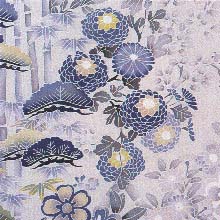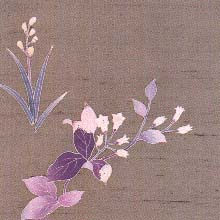Dye (p. 60 )
1. Produced in Kanazawa City, Ishikawa Prefecture.
2. Characteristics: A method of dyeing designs with the sizing method traditionally carried on in Kanazawa area (Kaga) mostly hand painted. Many colors are used with the basic 5 colors: indigo, crimson, ocher, purple and black. The color gradation in a design is usually made from the inner side of the line toward the center, in contrast to the "Kyoto Yuzen". The designs are picturesque in general as seen in "Mushikui"(vermiculation) which depicts worm eaten leaves. The designs in " Kaga Yuzen" are the ones made like the designs of those in Kyoto Yuzen. No embroidery or metal foils are used.
3. History: Since days of old, there has been a technique of dyeing plain hemp fabrics with the astringent juice of plum " Ume". The technique was applied to silk fabrics at the encouragement of the feudal government in the Kanbun Era (1611-1673) , giving birth to a method of dyeing designs called "Kaga Zome"."Itchin Nori" was then used as a resistant: it was kneaded flour boiled with sugar, slaked lime and glue plant juice. The glue was put on the designs with the tips of chopsticks or toothpicks. The craftsmen managed skillfully to apply the liquid glue, which hung like thread, on the designs. The glue was removed after all the parts were dyed. Later, cylinders were used for putting on the glue and the designs were hand painted. These designs were called "Iroe "(color picture.) This technique was applied to family crests and called "Iroe Mon"(color picture crest.) Yuzensai Miyazaki, a painter from Kyoto who moved to Kanazawa in 1718, applying the " Yuzen "designs to the traditional dyeing in Kanazawa. The name of "Kaga Yuzen " appeared in the years after the Meiji Period.
Dyeing Method
Steps for dyeing is the same as those of " Kyo Yuzen."
1. Temporary tailoring of the kimono with plain white fabrics
2. Drawing the sketch of the designs
3. Putting the resistant glue where it is needed
4. Giving colors to the designs
5. Vaporizing the cloth to fix the colors
6. Putting the resistant glue where it is needed
7. Dyeing all background
8. Vaporizing the cloth to fix the colors
9. Washing cloth in water
10. Finishing after drying
"Hanayome Noren" is said to be the origin of " Kaga Yuzen" a sheet of cloth on which felicitous designs such as "Shochikubai"(pine leaves, bamboo and plum flowers) or "Tsurukame"(crane and tortoise) are hand dyed and used as one of the bridal items.




